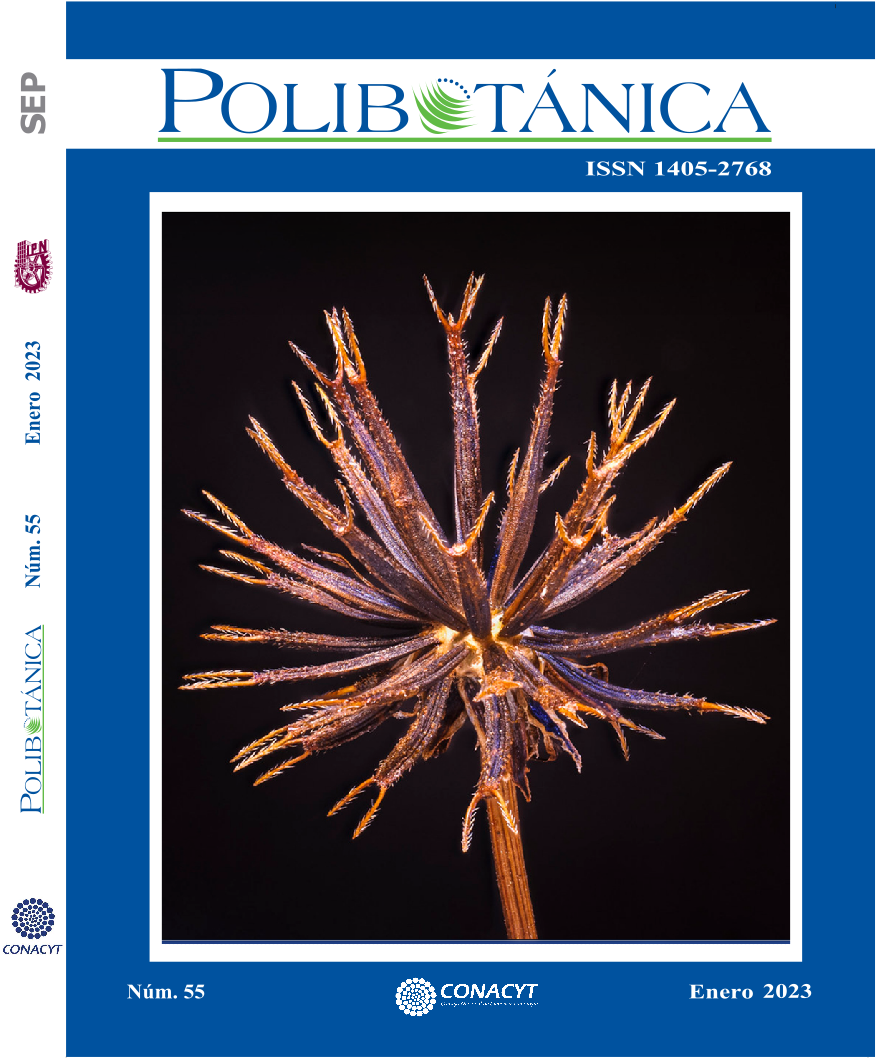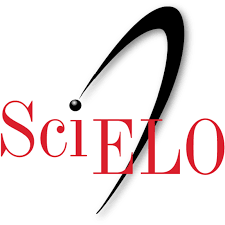Antioxidant and cytotoxic activity of essential oil from aromatic bay leaves (Litsea glaucescens Kunth)
DOI:
https://doi.org/10.18387/polibotanica.55.7Keywords:
cytotoxicity, Artemia salina, Gas chromatography, ABTS test, FRAP test, aromatic laurelAbstract
FRAP and ABTS methods were used in a microplate lector to evaluate the antioxidant activity and the bioassay of Artemia salina was used to assess the cytotoxic activity of the essential oils obtained from several samples of aromatic laurel (Litsea glaucescens) plant species non-timber forest (NWFP) widely used in Mexico. Currently it is registered in the Official Mexican Standard (NOM-059- SEMARNAT- 2019), with the category of P (in danger of extinction) and is used for the treatment of cold diseases, headaches and also paralysis. The highest antioxidant capacity of the essential oils analyzed by ABTS corresponded to the sample of Zongolica, Veracruz with 12.89 μmol ET/μL while with the FRAP method the one with the highest antioxidant activity was for a sample obtained from the Soriana shopping center, with 0.17149 μmol ET/mL. The sample of essential oil obtained from the Soriana marked in the Artemia saline test exhibited the highest cytotoxic activity with a CL50 of 53.8 μg/mL and the one with the lowest activity corresponded to the oil sample prepared from the collection of Nopalillo, Hidalgo (oyamel forest) with a CL50 of 451.6 μg/mL The analysis in Gas chromatography coupled to mass spectrometry, evidenced the presence of: 34.99% eucalyptol (1,8-cineole), 7.45% 1R-α-Pinene, 6.51% L-Limonene, 5.26% trans-dihydrocarvone, 4.62% (-)-β-Pinene, 4.46% bornyl acetate, 4.11% trans-4-Thujanol, 3.85% Canphene, 3.06% γ-terpinene and 2.91% caryophyllene, These results indicate the possibility of using the essential oils of L. glaucescens, for their antioxidant and cytotoxic properties, offering an alternative to use as antimicrobial..
References
Azhar, M.A.M., Salleh, W.M.N.H.W., Khamis S., Ghani. N.A. (2022). Variation in essential oil composition of three Litsea species from Malaysia. La rivista italiana delle sostanze grasse - Vol. XCIX, 1-6. https://www.researchgate.net/publication/360540412
Andreatta, E. A., Longo, B. M., Utrera, C., Saavedra, M. y Foco, G. (2012). Caracterización de Aceites Esenciales del Departamento San Justo (Córdoba). Jornadas de Ciencia y Tecnología. Universidad Tecnológica Nacional de Villa Maria, Córdova, Argentina. Disponible en: http://www.edutecne.utn.edu.ar/cytal_frvm/cytal_2012/tf/tf008.pdf
Arango, O. A., Pantoja, D., Santacruz, L, Hurtado A. (2012). Actividad antioxidante del aceite esencial de orégano (Lippia origanoides HBK) del Alto Patía, Biotecnología en el Sector Agropecuario y Agroindustrial, 10 (2), 79-86. Disponible en: http://www.scielo.org.co/scielo.php?pid=S1692-35612012000200010&script=sci_abstract&tlng=es
Benzie, I, F,F, y Strain, J.J. (1996). The Ferric Reducing Ability of Plasma (FRAP) as a Measure of “Antioxidant Power”. The FRAP Assay Analytical Biochemistry, 239, 70-76. https://doi.org/10.1006/abio.1996.0292
Camacho P, Cáceres A, Rodríguez J. (2011). Extracción de aceite esencial de eucalipto. Recuperado de https://es.scribd.com/doc/48247006/Extraccion-de-aceites-esenciales-informe
CYTED: Programa lberoamericano de Ciencia y Tecnología para el Desarrollo. 2014. Consultado en: http://www.cyted.org. Accesado 24 de enero de 2022.
Damasceno, Carolina Sette Barbosa, Letícia Freire de Oliveira, Ellis Marina Szabo, Ângela Maria Souza, Josiane Fatima Gaspari Dias, Marilis Dalarmi Miguel, and Obdúlio Gomes Miguel. (2017). “Chemical Composition, Antioxidant and Biological Activity of Ocotea Bicolor Vattimo-Gil (LAURACEAE) Essential Oil.” Brazilian Journal of Pharmaceutical Sciences 53(4). doi: 10.1590/s2175-97902017000417298.
De, Jefferson R., A. Silva, Dominique F. M. do Carmo, Érika M. Reis, Gérzia M. C. Machado, Leonor L. Leon, Bianca O. da Silva, José Luiz, P. Ferreira, Ana Claudia, and F. Amaral. (2009). Chemical and Biological Evaluation of Essential Oils with Economic Value from Lauraceae Species. Vol. 20. https://doi.org/10.1590/S0103-50532009000600011
Esteyneffer, J. 1978. (1712). Florilegio medicinal. Mexico: Academia nacional de medicina, 1978 Description: 2 vol. (XXIII-537 p.; XII-p. 543-973); 21 cm
Guzmán Gutiérrez, S. L., Gómez- Cansino, R., Gracia- Zebadúa, J. C., Jiménez- Pere, N. C., y Reyes- Chilpa, R. (2012). Atidepressant activity and Linalool as active principales. Journal of ethnopharmacology, 143(2), 673- 679. https://doi.org/10.1016/j.jep.2012.07.026
Hammid, Syaliza Abdul, y Fasihuddin Ahmad. (2015). Chemotype of Litsea Cubeba Essential Oil and Its Bioactivity. Nat. Prod. Commun. 10, 1301–1304. Disponible en: https://journals.sagepub.com/doi/pdf/10.1177/1934578X1501000741
Jiménez Pérez, N.C., F.C. Lorea Hernández, C.K. Jankwoski y R. Reyes Chilpa. (2011). Essential oils in Mexican bays (Litsea spp., Lauraceae): taxonomic assortment and ethnobotanical implications. Economic Botany 65(2):178-189. DOI:10.1007/s12231-011-9160-5.
Kuspradini, H., Wulandari, I., Putri, AS, Tiya, SY y Kusuma, IW (2018). Propiedades fitoquímicas, antioxidantes y antimicrobianas de los extractos de Litsea angulata. F1000Research, 7, 1839. https://doi.org/10.12688/f1000research.16620.2
Lee, S. J., Umano, K., Shibamoto, T., & Lee, K. G. (2005). Identification of volatile components in basil (Ocimum basilicum L.) and thyme leaves (Thymus vulgaris L.) and their antioxidant properties. Food Chemistry, 91(1), 131-137. https://doi.org/10.1016/j.foodchem.2004.05.056
López, J., W. Barillas, J. Gómez, F. Lin, A. Al, M. Sharaf y P. Schiff. (1995). Flavonoids of Litsea glaucescens. Planta Médica 61(2):198. DOI: 10.1055/s-2006-958054
Lorea-Hernández, F. G. (2002). La familia Lauraceae en el sur de México: diversidad, distribución y estado de conservación. Boletín de la Sociedad Botánica de México, (71), undefined-undefined. Disponible en: http://www.redalyc.org/articulo.oa?id=577/57707104.
Meyer, B.N., Ferrigni, N.R., Putnam, J.E., Jacobsen, L.B., Nichols, D. E., Nicols, J. L., McLaughlin, J. (1982). Brine Shrimp: A Convenient General Bioassay for Active Plant Constituents. Planta Medica. 45(5):31-4. DOI: 10.1055/s-2007-971236
Michael, A. S., Thompson, C. G., Abramovitz, M. (1956). Artemia salina as a test organism for a bioassay. Science 123: 464. DOI: 10.1126/ciencia.123.3194.464.a
Montañez-Armenta, M. P. (2006). Proceso de organización social para el aprovechamiento del Laurel silvestre (Litsea glaucescens) en la Sierra del Laurel, Aguascalientes. Instituto en Socioeconomía, Estadística e Informática, Desarrollo Rural. Colegio de Postgraduados. Montecillo, Texcoco, Edo. de México. México. 110 p. Disponible en: https://dialnet.unirioja.es/servlet/articulo?codigo=4471093
Moreno, J.; López, G.; Siche, R. (2010). Modelación y optimización del proceso de extracción de aceite esencial de eucalipto (Eucalyptus globulus). Scientia Agropecuaria 1(2): 147-154. https://www.redalyc.org/articulo.oa?id=357633695005
Norma Oficial Mexicana NOM-059-SEMARNAT-2019. (2019). Protección ambiental-Especies nativas de México de flora y fauna silvestres-Categorías de riesgo y especificaciones para su inclusión, exclusión o cambio Lista de especies en riesgo. Disponible en: http://dof.gob.mx/nota_detalle.php?codigo=5173091&fecha=30/12/2010
Osuna, L., M.E Tapia y A. Aguilar. (2005). Plantas medicinales de la medicina tradicional mexicana para tratar afecciones gastrointestinales. Estudio 33 etnobotánico, fitoquímico y farmacológico. España. Universidad de Barcelona. 173p. Disponible en: http://www.publicacions.ub.es/refs/indices/06499.pdf
Politeo, O., Jukić, M., & Miloš, M. (2006). Chemical composition and antioxidant activity of essential oils of twelve spice plants. Croatica chemica acta, 79(4), 545-552. https://www.researchgate.net/publication/27191465
Re R., N. Pellegrini, A. Proteggente, A. Pannala, M. Yang y C. Rice-Evans. (1999). Antioxidant Activity Applying an Improved ABTS Radical Cation Decolorization Assay. Free Radical Biology and Medicine: 26 (9/10), 1231-1237. DOI: https://doi.org/10.1016/S0891-5849(98)00315-3
Sánchez-Yañez M. T., Rojas Molina R., Wong Paz J.E. y Muñiz Márquez D.B. (2020). Estudio del potencial antioxidante de aceites esenciales de laurel, orégano y damiana pretratados con ultrasonido. Tecnológico Nacional de México Campus Ciudad Valles. Revista de divulgación científica y tecnológica. ISSN: 2444-4944. Vol. 7 No. 1. Disponible en: https://www.eumed.net/uploads/articulos/7a516d7405cea7cc357e57b8602ae597.pdf
Stashenko, E.E., Ferreira, C., Sequeda, G., Mateus, A., Cervantes, M. & Martínez, J.R. (1997). “Desarrollo de un método para monitoreo de la degradación oxidativa en lípidos y evaluación de la actividad antioxidante de productos naturals”, Arte y Ciencia Cosmética 12: 20-27. Disponible en: https://www.academia.edu/4147663/
Sundararajan, B., Moola, A.K. Vivek, K., Ranjitha Kumari, B.D. (2018) Formulation of nanoemulsion from leaves essential oil of Ocimum basilicum L. and its antibacterial, antioxidant and larvicidal activities (Culex quinquefasciatus). Microbial Pathogenesis 125, 475-485
Uddin, Mohammad Najim, Towsif Alam, Muhammad Azharul Islam, Tawhidul Amin Khan, Raihan Uz Zaman, Shofiul Azam, A. T. M. Mostafa Kamal, and Md Jakaria. (2020). “Evaluation of Carbon Tetrachloride Fraction of Actinodaphne Angustifolia Nees (Lauraceae) Leaf Extract for Antioxidant, Cytotoxic, Thrombolytic and Antidiarrheal Properties.” Bioscience Reports 40(6). DOI: 10.1042/BSR20201110
Valdés, J. and H. Flores. (1985). Comentarios a la historia de las plantas de la nueva España. In: Obras completas de Francisco Hernández, Tomo VII, 179. Universidad Nacional Autónoma de Mexico, México.
Van der Werff, H., y Lorea Francisco. (1997). Flora del Bajío y de Regiones adyacentes: Familia Lauraceae. Instituto de Ecología A.C., Xalapa, Ver. México. Fascículo 56. pp. 25-31. DOI: https://doi.org/10.21829/fb.259.1997.56
Vásquez, O.; Alva, A.; Marreros, J. (2001). Extracción y caracterización del aceite esencial de Jengibre (Zingiber officinale). Revista Amazónica de Investigación Alimentaria 1(1): 38-42. Disponible en: https://www.yumpu.com/es/document/read/12717797/
Downloads
Published
Issue
Section
License

Polibotánica by Departamento de Botánica de la Escuela Nacional de Ciencias Biológicas del Instituto Politécnico Nacional se distribuye bajo una Licencia Creative Commons Atribución-NoComercial-CompartirIgual 4.0 Internacional.




















